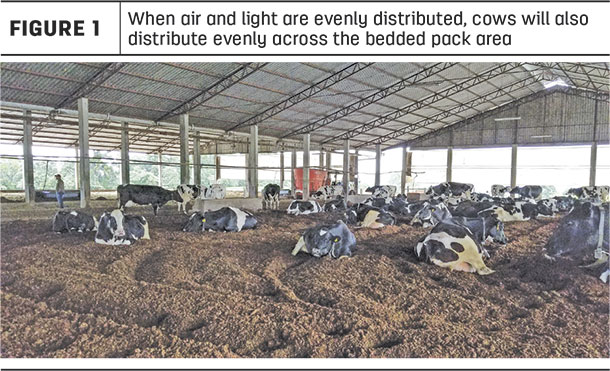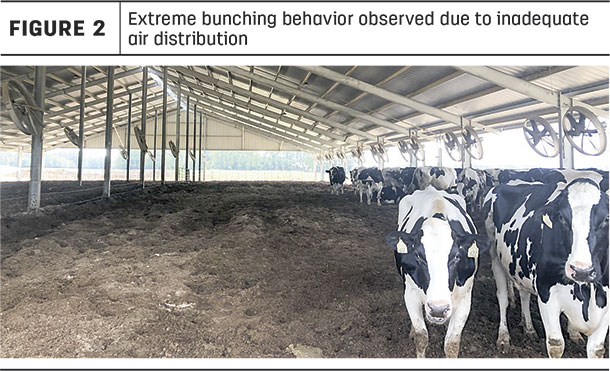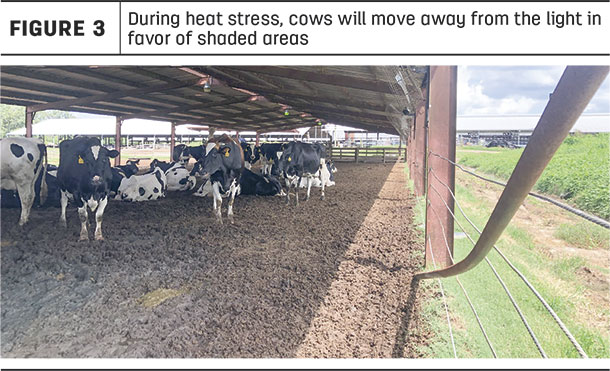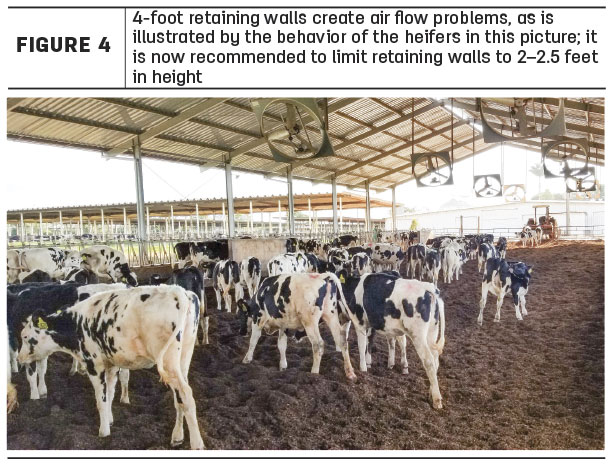What differentiates a compost-bedded pack barn from a traditional-bedded pack barn is that the bedding is tilled or stirred frequently to enhance the microbial activity that leads to composting and the drying of bedding. Stirring the bedding two to three times a day is recommended for optimal composting.
In the United States, most compost-bedded pack barns use sawdust or wood shavings as a source of carbon to mix with the manure to achieve the carbon-to-nitrogen (C-N) ratio needed for composting. Compost-bedded pack barns provide excellent cow comfort, allowing cows to lie down easily and rise without stall restrictions. However, to achieve the desired results, compost-bedded pack barns must be constructed and managed correctly (Figure 1). As an industry, we have learned a great deal about what makes these barns either successful or unsuccessful over the last decade, as many of the challenges and failures observed are related to sub-optimal lighting and air flow.

Bunching behavior: Problems with light or air often result in bunching or grouping behavior within all dairy facilities, but this issue is exacerbated in compost-bedded pack barns. Bunching behavior can be observed when cows gather or bunch together in a particular part of the barn and avoid the remaining areas of the barn. In extreme situations, cows may only use 10–20% of the provided space (Figure 2).

This behavior, which occurs almost exclusively during conditions that can lead to heat stress, is thought to be an evolutionarily engrained response to stress in general. In the wild, cows are prey animals, and bunching together protects them from predators. In the case of heat stress, this response is misguided, as it often worsens heat stress because of the increased body heat created when cows are in such close proximity to each other.
Bunching behavior is more extreme and noticeable in compost-bedded pack barns because there are fewer physical restrictions separating the cows from each other. General heat stress, flies, light and air often lead to bunching behavior. Another potential contributing factor to bunching behavior in compost-bedded pack barns is the effect of pack heating on resting behavior.
Although the surface temperature of a compost-bedded pack barn is within a few degrees of ambient temperature, how compost heating affects lying behavior in hot, humid environments is unknown. Anything we can do to lower heat stress or reduce the fly population may also decrease the instances of bunching behavior.
Barn orientation and light: Barn orientation has a significant impact on the natural light patterns within a dairy barn. An east-west orientation allows for the least sunlight penetration into a barn and, as such, is highly recommended for compost-bedded pack barns. With an east-west orientation, the sun moves over the top of the barn throughout the day, whereas with a north-south orientation, the sun moves over the broader sides of the barn, creating more light intensity in the cows’ resting or eating areas.
During heat stress conditions, cows will move away from areas with more light and move toward darker parts of the barn (Figure 3). Cows are much more sensitive to subtle differences in light intensity than humans are, and cows associate dark with shade. Of course, there are times of the day when light can be problematic for every orientation; however, the east-west orientation results in a much lower percentage of the day during which the lighting intensity could affect cow distribution.

Bunching behavior in compost-bedded pack barns is much more common and more pronounced in north-south-oriented barns than in east-west-oriented barns. Thus, an east-west orientation is recommended when constructing a new compost-bedded pack barn. This issue might be avoided in north-south-oriented barns if feed bunks are positioned on the outer sides of the barn rather than in a drive-through layout.
Additional lighting considerations: The challenges related to light intensity can also be partially addressed with eave overhangs. Eave overhangs, which should be equal to one-third of the height of the sidewall, can help provide some shade and protection from precipitation. Shade can help but must be used with considerable care, as even porous shade cloth impedes air flow. Use caution to ensure that fixing the lighting problem doesn’t inadvertently create an air-flow problem.
Supplemental, artificial light can also be used to reduce light variation and improve cow distribution. The recommended light level for dairy cows can be provided by 20-foot candles (200 lux). You can use a digital light meter to measure light intensity within a barn. For demonstration purposes, you can also download free light meter applications on your smartphone but be aware that these applications are likely not as accurate as light meters. With a light meter, you can identify which areas of the barn have lower light intensity. Then, you can add artificial lighting (ideally, LED) to better distribute light within the barn during the day. Wiring the lights so that different sections can be turned on and off at different times provides the flexibility to use lights within darker sections of the barn to even out light intensity. Creating consistent light intensity across the barn has been used to reduce instances of bunching.
Ventilation and barn design: Most compost-bedded pack barns rely on natural ventilation supplemented with mechanical ventilation. To maximize the natural ventilation, the barn must be designed correctly. Ventilation removes the heat and moisture created by the cows and the composting process. In compost-bedded pack barns, ventilation is critical not only for cow cooling but also for pack drying.
Sidewalls should be at least 12 feet above the retaining wall or outside curb. A height of 14 feet is recommended for barns wider than 40 feet. For example, if a 100-foot-wide barn has a 2-foot concrete wall, the total sidewall height should be 16 feet. Early compost-bedded pack barns used 4-foot retaining walls for manure storage and to keep the bedding within the structure. Practical and computer-modeling experiences, however, have demonstrated that 4-foot retaining walls block the air flowing onto cows lying down. The current recommendations are to use a 2–2.5-foot retaining wall instead to improve cow-level air flow (Figure 4).

The recommended roof pitch is 4/12 to maximize the natural ventilation rate per cow. A roof that is too flat for a wide barn limits the natural ventilation rate and can easily create pockets of warm, moist air. A continuous ridge vent opening of at least 3 inches for every 10 feet of roof width is recommended, with a minimum opening of 12 inches for barns smaller than 40 feet wide. Air flows into the barn through the windward sidewalls and is exhausted through the ridge vent and the leeward wall opening. Ridge vents are generally more effective if the prevailing winds are perpendicular to the ridgeline.
Fans: Circulation fans, either ceiling or panel, are recommended to help keep the pack dry and ensure adequate air speeds throughout the barn. Many farms have installed high-volume, low-speed (HVLS) ceiling fans in their compost-bedded pack barns, and these appear to work well. When installing fans, it is important to ensure that there is enough clearance for tillage equipment to work underneath them at maximum pack depth and that the fan blades will not damage the barn trusses. In addition to fans over the pack area, most compost-bedded pack barns include sprinklers with panel fans over the feedbunk for evaporative cooling.
Inadequate or improperly placed fans are one of the biggest issues observed in compost-bedded pack barns. Since the space per cow in a compost-bedded pack barn is much larger than in a freestall barn, fan installation and maintenance costs could be considered the biggest disadvantage to a compost-bedded pack barn. Additionally, in a compost-bedded pack barn, the entire space needs to be considered, whereas, in a freestall barn, we are generally not concerned with fans in alleys.
Unfortunately, decisions about fans in compost-bedded pack barns are often made after the barn is constructed. Instead, they should be factored into the primary decision of whether to build a compost-bedded pack barn or a freestall barn and should also be considered during the design of the new barn. Too often, we come across barns that could be distributing air much more effectively if only the barn dimensions had been adjusted to better accommodate fan needs.
Regardless of the type of fans chosen, taking spacing into consideration is critical in order to avoid dead spaces. Dead spaces create an uneven distribution of cows within a compost-bedded pack barn and contribute to bunching behavior. Cows will ultimately tell us where the fans should have been; they will lie in rows in front of panel fans and will lie in circles underneath HVLS fans. With fans, the goal is to achieve air flows of 400-600 feet per minute (i.e., 5-7 miles per hour) at cow level. HVLS fans are advantageous in that they cover a larger area per fan, are more energy efficient and can easily run at lower speeds during the winter. However, even at maximum speed, they may only reach the lower threshold of the desired air speed to cool cows. Panel fans, on the other hand, easily achieve the recommended air speeds – but the side-to-side spacing needed to maintain even air distribution requires many panel fans.
Hanging fans in the middle of a pack barn can be a challenge. HVLS fans should be spaced at 2-2.5 times the diameter of the fan. In other words, a 20-foot HVLS fan will cover 40-50 feet horizontally and vertically. Manufacturers may recommend spacing at 3-4 times the diameter, but these recommendations are based on large, factory-type buildings, rather than for optimal cow comfort, and are insufficient. Clear dead spots, uneven air flow and cow bunching behavior have been observed in this type of spacing.
Panel fans need to be spaced longitudinally down the barn at no more than 10 times their blade diameter width. For example, 48-inch fans should not be placed more than 40 feet apart. With side-to-side spacing, there should be 6-10 feet between fans, and this is where most compost-bedded pack barns fall short. It is important to remember, though, that these are general recommendations, as individual instances of fan spacing are dependent on manufacturer guidelines and design features.
Let’s compare the recommended fan spacing for a 48-foot-by-204-foot long pack area. This barn would need five 24-foot HVLS fans down the center. In comparison, the same barn would need four 48-inch fans across, with five fans in each row, for a total of twenty 48-inch fans. Both arrangements should effectively cover the pack area. Purchase costs, electricity costs and personal preference may lead different operations to make different decisions.
Ultimately, whichever type of fan is chosen, it is important to know from the start how many fans are needed and to recognize that fan purchase and electricity costs are potentially some of the most important aspects to consider when deciding whether to build a compost-bedded pack barn. ![]()
PHOTO: Photo provided by Jeffrey Bewley.

-
Jeffrey Bewley
- Dairy Housing and Analytics Specialist
- Alltech
- Email Jeffrey Bewley






